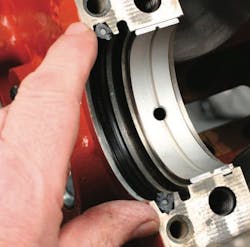Sealing an engine involves several concerns, including the containment of combustion pressure, preventing coolant and oil from entering the combustion process, and preventing oil, coolant and vacuum from leaking out of the engine. Theoretically this should be a straightforward process, but if performed incorrectly without attention to detail, problems can range from annoying leaks to devastating internal engine damage.
Sealing the rear main
Rear main leaks can be one of the most frustrating issues that a tech can face. While a minor leak may be livable (although annoying), a substantial oil leak that passes through the rear main sealing area can easily contaminate a clutch or present a serious-enough external leak to require repair, which translates into separating the transmission from the engine block all the way to requiring engine disassembly in order to access the rear seal. It’s not a comeback that any shop wants to see.
While early generation engines often used a two-piece rear main seal, late model rear seals commonly feature a one-piece design that establishes an oil seal between the crankshaft’s rear flange and the block’s rear engine cover. GM’s LS series of engines is a perfect example of this design. The seal is installed, not onto the block itself, but on the engine’s removable rear cover, much in the same way that an engine’s front cover (often called the timing cover) features a one-piece seal that rides on the crank’s front seal journal.
Citing the GM LS engine as an example, the rear main seal is installed to the engine’s rear cover, interference-fit in the same manner as you would install a timing cover seal. When installing the seal to the rear engine cover, make sure that the lips of the seal aim forward. Install a new rear cover gasket to the block (this gasket has a metal core design with an imprinted silicone seal, so no additional sealant is required).
With the seal installed to the rear cover, the rear cover is then installed to the rear of the engine block, with the seal engaging the crank’s rear flange.
Do not apply any lubricant to either the crank flange or the seal lips. The seal must be installed dry to the crank. If the seal lips are lubed prior to installation, there’s a very good chance that the seal will leak. An installation-aid white nylon guide is inserted onto the seal (this guide is usually included with a new rear seal). With the rear cover held “square” to the block, push the rear cover while carefully centering the rear seal to the crank flange. Once the seal engages to the crank flange, the white nylon guide will pop off. This guide helps to ensure that the seal lips are not pushed rearward. After installing the rear cover, inspect the seal closely to make sure that the seal lips have not been pushed rearward. Install the rear cover bolts finger-tight. The rear cover features two studs or bolts that secure the rear of the oil pan to the bottom of the rear cover. Snug the two lower vertical bolts or stud nuts first, which draws the bottom of the rear cover toward the oil pan. Then torque all rear cover bolts to 18 ft.-lbs.
NOTE: The GM LS crankshaft rear flange may feature flywheel bolt holes that are open to the crankcase. Be sure to apply a thread sealant to the flywheel bolts to avoid a leak that could be caused by oil traveling past the flywheel bolts.
Naturally, follow the specific rear main seal installation procedure for the make, model and year of the engine at hand. I’ve referred to the LS engine merely as one example.
[PAGEBREAK]
Cylinder head studs
Although not common on most production engines, you may encounter an engine wherein the cylinder heads are secured with studs and nuts instead of bolts. Studs should never be torqued to the block with any amount of force that is anywhere in the neighborhood of the published clamping force. In the case of cylinder head studs,for example, the studs need to only be finger-tight or with a very small preload of perhaps 5 ft.-lbs. to 10 ft.-lbs. (adhere to the specs in the service manual or the stud maker’s instructions).
Tightening the nuts onto the studs creates the necessary clamping load — the studs only need to be fully engaged into the block deck. Over-tightening the studs into the block will only create a splaying condition (where the installed angle of the studs can easily deviate from 90 degrees), making cylinder head installation difficult and adversely affecting the required clamping load when the nuts are torqued.
One issue to bear in mind deals with cylinder head bolt or stud thread sealing. If the thread holes in the block are blind, there is no need for any type of sealant. Simply lubricate the stud or bolt threads. If any of the threaded holes are open to either oil or coolant, only then is a thread sealant needed.
As I mentioned earlier, there is no need to apply a bunch of torque to install the studs into the block. Some builders may prefer to “anchor” the studs in place to prevent stud loosening during future engine service. With regard to cylinder head studs, this really isn’t necessary unless you plan to routinely remove and reinstall the heads. But if you do opt to chemically hold the studs in place, avoid the use of an anaerobic compound (a thread locking compound). A thread locking compound may expand as it cures, and if the cylinder walls are relatively thin (possibly due to a recent overborek, for example), and if the thread holes are in close proximity to the cylinder walls, this mechanical expansion can result in excessive pressure, with the potential for cracking of the cylinder wall. If you are bound and determined to “glue” the studs in place, a better alternative is a two-part epoxy such as JB Weld. This will harden without expanding and can easily be broken-down for stud removal by applying torch heat. Another alternative is a high-temperature RTV. Again, there is really no need to try to “anchor” studs to the block via excessive torque or a thread locking compound. Simply obtain full thread engagement, and let the tightening of the nut apply the required clamping force torque.
Rocker bolt holes
In some engine designs, again citing the GM LS series as an example, the intake rocker arm bolt holes in the heads are open to cylinder head intake ports. Because of this, a thread sealer should always be applied to the intake rocker arm bolts in order to avoid potential vacuum leaks. An adequate sealer is Teflon thread sealing paste. Do not use Teflon tape, as this presents the potential for a stringy piece of tape to become dislodged and present a possible contamination issue.
Each engine design has its own quirks, so unless you’re already very familiar with a specific engine, take the time to research and pay attention to the factory service manual for any special notes regarding engine assembly and/or sealing concerns before blindly beginning assembly.
Whenever you deal with fuel system plumbing that involves a threaded connection, chances are that you’ll be dealing with a straight thread connection that features either a tapered seat or a sealing aluminum or copper “crush” washer. In either case, no additional sealing material will be needed. If the connection features a tapered seat, make sure that both male and female tapered surfaces are clean and free of burrs. If a crush washer is involved, always use a new crush washer.
A note regarding copper or aluminum crush washers: You may encounter an initial installation (tightening the fitting only once) that results in a minor leak. If that’s the case, loosen the fitting and re-tighten. In some instances, the soft-metal crush washer may need to be compressed more than once to achieve a positive seal, to “find a home.”
If a tapered thread is involved (as opposed to straight threads), a sealing material is always required. A good choice is a Teflon paste. DO NOT use Teflon tape. If you’re not extremely careful, excess tape material that is not fully captive inside the threads can break off and enter the fuel stream, potentially clogging small ports in a carburetor (such as the needle and seat) or critically small passages inside fuel injectors. If a sealing material is required, use a minimal amount of Teflon paste.
Cylinder head gaskets
Cylinder head gaskets are all too commonly blamed when a leak occurs between the block deck and head. The over-used term “a blown head gasket” is uttered whenever this happens. A head gasket can be viewed somewhat as a “fuse,” where the gasket itself isn’t the root of the problem, but where something has taken place to cause the gasket to fail. The cause of the problem might be a warped cylinder head, improperly surfaced block deck and/or head deck surfaces, improper tightening of the cylinder head fasteners, or excessive overheating of the engine that has caused the head to distort.
Before simply replacing a “bad” head gasket, you need to closely examine the mating decks of both the block and head. These surfaces must be checked for both flatness and for surface finish. Clean the block decks and cylinder head decks to remove all foreign deposits. DO NOT use an abrasive pad on a power tool, as this can easily result in creating waviness on the deck surfaces. It might look nice, but it won’t be flat.
[PAGEBREAK]
Once the decks are clean, always check each block and head deck for flatness with a precision machinist’s straightedge and a feeler gauge. Perform the check from front to rear, and diagonally across opposing corners. While old-school warpage limits for the length of the deck may be about 0.003 inch for V6 heads, 0.004 inch for V8 heads and as much as 0.006 inch for straight-six heads, most late model aluminum heads sealed with MLS (multi-layer steel) gaskets require tighter tolerance ranges.
Generally speaking, any deviation (gaps) of more than about 0.002 inch along deck length or diagonal measurements is unacceptable, requiring the offending deck(s) to be re-machined flat. Don’t make assumptions. Always refer to the service manual for the tolerance specification for any given engine. Also check for any isolated scratches or gouges on the deck surfaces, which can create pressure-loss leaks between the deck and gasket. Each engine design will specify a roughness average (Ra) in terms of surface finish. A specific range of surface finish is required for any given engine, in order for the head gasket to properly seal as designed.
Never attempt to re-surface any deck unless your shop has a qualified engine machinist on hand. Otherwise, farm the resurfacing out to a local engine machine shop.
Always select the proper type of head gasket for the application (composite or MLS). MLS head gaskets are commonly used in late model engines. This type of head gasket features multiple layers of material, with formed sealing beads that are designed to crush to seal. An additional sealant imprint is commonly featured as well to aid in fluid sealing.
When installing the new head gasket, pay close attention to gasket orientation. In many cases, the cooling passages on the block decks may not be symmetrical (not a mirror image front to rear). Refer to both the factory service manual and to the head gasket maker’s instructions for proper gasket placement in order to prevent blocking off a critical coolant passage. Many high-quality cylinder head gasket makers will print the word “FRONT” at one end of the gasket, as a reminder of gasket orientation.
Cylinder head guide dowel sleeves or pins will be present on the block deck. Never install a gasket and head without these locating dowels. The dowels precisely locate both the gasket and head on the block in order to align all bolt locations and all passages. If the original dowels are damaged or missing, always obtain and install new dowels.
Follow the service manual (or bolt/stud maker’s instructions) with regard to thread treatment.
Depending on the application, either a clean engine oil or a moly-type thread lubricant must be applied to the bolt threads (and the underside of the bolt heads). When dealing with head studs, this lubricant must be applied to the upper threads and to the bottom of the nuts. The type of lubrication has a direct bearing on the applied torque. Moly reduces friction between the threads, more-so than oil. If aftermarket head bolts or studs are being used, the manufacturer will likely provide two different torque specs, one for oil and one for moly. If you use moly but follow the torque spec for oil, you will over-tighten the fasteners. If you use oil but follow moly spec, you may under-tighten. Pay attention to the specified thread lube and the appropriate torque spec.
Both fastener clamping load and tightening sequence are absolutely critical to achieve a proper head gasket seal. NEVER guess at the tightening sequence. Refer to the OE repair manual (or aftermarket cylinder head instructions) for the tightening pattern and tightening phases. Tighten cylinder head fasteners in steps. For example, if a torque specification calls for a final 70 ft.-lbs., begin (in the correct sequence) with 20 ft.-lbs., followed by 40 ft.-lbs., etc., until final torque is achieved. Never fully tighten one fastener at a time. Uneven clamping load distribution can easily deform (warp) a cylinder head, resulting in a gasket leak, which will be no fault of the gasket itself.
Formed/molded gaskets
Many of today’s engine components are sealed with the use of a formed silicone/rubber/elastomer bead seal. Providing the mating surfaces are flat and clean, there is usually no need to apply any additional chemical sealant to this style of gasket or seal.
Avoid re-using original formed-in place bead seals. Considering the relatively low cost of the seals, it makes sense to always install a new seal, even if the original appears to be in good shape. It’s better to spend a couple of extra bucks in order to avoid the need to perform the job again, should a leak occur due to a damaged or aged original seal.
[PAGEBREAK]
Sealing chemicals
While gaskets and formed seals apply to the majority of engine sealing issues, there are instances where an additional sealing compound is required, such as where component corners meet, creating a potential gap, or where a metal-to-metal joint must be addressed. Also, when dealing with a less-than-ideal mating area (such as a distorted oil pan or corroded valve cover lip, etc.), an additional sealing compound may be needed to ensure against leakage. In addition, there are applications wherein the OE specification calls for the use of a packing material instead of a cut or formed gasket (packing material is a term often used by OEMs to refer to sealing compounds such as RTV).
Speaking in very broad terms, there are two basic families of sealing compounds — anaerobic and RTV. An anaerobic sealant is designed to cure in the absence of air (an example is a thread locking compound that cures once the bolt/nut is fully tightened). An RTV (room temperature vulcanizing) sealant cures by exposure to air. Depending on the specific application, an array of dedicated compounds are available to address a wide range of sealing requirements, based on anticipated temperatures, vibration resistance and exposure to different fluids, such as coolant, engine oil, transmission fluid, fuel, etc. Excellent sources of reference include such brands as Permatex, Valco and others, where detailed information regarding the proper selection of sealant is readily available. When a sealing compound is required, don’t just grab any tube of RTV that might be handy. Be sure to use the correct type for the specific application. ●
Author’s note:
The subject of engine sealing deserves to be discussed at great length. Given the limited space provided in this article, we’ve addressed a few common areas. Always refer to the appropriate service manual for the specific engine at hand. Following the proper assembly techniques for a specific engine will avoid leakage complaint comebacks.



